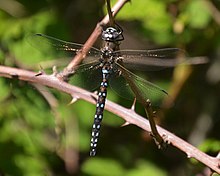| Rhionaeschna californica | |
|---|---|

| |
| Conservation status | |
 Least Concern (IUCN 3.1) | |
| Scientific classification | |
| Domain: | Eukaryota |
| Kingdom: | Animalia |
| Phylum: | Arthropoda |
| Class: | Insecta |
| Order: | Odonata |
| Infraorder: | Anisoptera |
| Family: | Aeshnidae |
| Genus: | Rhionaeschna |
| Species: | R. californica |
| Binomial name | |
| Rhionaeschna californica (Calvert, 1895) | |
| Synonyms | |
| |
Rhionaeschna californica, the California darner, is a species of darner in the dragonfly family Aeshnidae. It is commonly found in Central America, along the West Coast of the United States, and in Southwestern Canada. The California darner prefers habitats like lakes, ponds, marshes and stream pools with edge vegetation including many with alkaline water conditions Larvae sustain themselves on a diet of aquatic insects,very small fish and tadpoles. The adult-stage will eat almost any soft-bodied flying insect.
The IUCN conservation status of Rhionaeschna californica is "LC", least concern, with no immediate threat to the species' survival. The population is stable. The IUCN status was reviewed in 2017.
Description
As an adult, the California darner is described as a medium-sized dragonfly, typically measuring between 5.7 to 6.4 centimeters (2 ¼ to 2 ½ inches) in length. California darners are best distinguished by their distinct bright blue diagonal spots on their abdomen.
Male California darners have a dark brown to brownish-black body with two blue or green diagonal stripes across each side of the thorax, while the top thorax is plain in color. Most females are polymorphic, although exhibit the same color scheme as males, they may also have greenish yellow markings instead of blue. Females are also heteromorphic with their eyes being light brown in comparison to the males' blue eyes.
Distribution and habitat
The adult flight season occurs during the warmer months, typically occurring from mid-April to late June, which makes it one of the earliest dragonflies to appear during the spring season. In California, they are noted to have a flight season from February to August.
California darners are most commonly found throughout the Western United States, with the highest concentration stretching from Baja California to the south of Mexico. They can also be spotted in some parts of Canada, like Vancouver, and in regions of Central America.
The California darner, like many other dragonflies, thrives in aquatic environments with abundant freshwater sources. Accordingly, they gravitate toward freshwater bodies such as lakes, ponds, and marshes at lower elevations. With regard to climate, the California darner is most commonly found in Mediterranean climates, such as California, which is semi-arid, exhibiting wet winters and dry summers.


Life Cycle
The California darner typically spends several years maturing from a naiad before transitioning into their adult dragonfly form. When this transformation occurs, it occurs at night, which is believed to be an adaptation in order to avoid being preyed upon by diurnal predators such as birds, frogs, and fish.
Diet
As naiads, they primarily prey on aquatic invertebrates, such as larvae from various insects or even freshwater shrimp. However, they are not limited to just invertebrates, they will also prey on small fish and tadpoles as well.
Once they reach adulthood, the California darner typically preys on soft-bodied insects such as mosquitoes, flies, and butterflies.
Behavior
Males fly along the shore, right above open water next to riparian zones, in search of female partners to mate with. California darners primarily mate at night, and they often perch near trees to begin copulating. The mating process between the pair generally lasts five to twenty minutes. Female California darners will then lay their eggs on top of vegetation at water level, such as vertical stems or even floating leaves.
References
- Paulson, D.R. (2017). "Rhionaeschna californica". IUCN Red List of Threatened Species. 2017: e.T50967530A65836194. doi:10.2305/IUCN.UK.2017-3.RLTS.T50967530A65836194.en. Retrieved 13 November 2021.
- ^ "Rhionaeschna californica Report". Integrated Taxonomic Information System. Retrieved 2019-09-25.
- "Rhionaeschna californica". GBIF. Retrieved 2019-09-25.
- ^ "Rhionaeschna californica Red List status". IUCN Red List of Threatened Species. Retrieved 2019-09-25.{{cite iucn}}: old-form url (help)
- "Rhionaeschna californica species Information". BugGuide.net. Retrieved 2019-09-25.
- ^ Webmaster, David Ratz. "California Darner - Montana Field Guide". fieldguide.mt.gov. Retrieved 2022-12-15.
- "Odonata Central". Retrieved 2019-07-02.
- "World Odonata List". Slater Museum of Natural History, University of Puget Sound. 2018. Retrieved 2019-07-02.
- ^ "California Darner". digitalatlas.cose.isu.edu. Retrieved 2024-10-23.
- ^ "California Darner". digitalatlas.cose.isu.edu. Retrieved 2024-10-23.
- ^ Palanca, Salamat, Jewel, Marissa. "Odonata Field Guide" (PDF). Odonata Field Guide.
{{cite journal}}: CS1 maint: multiple names: authors list (link) - ^ Paulson, Dennis (2009). Dragonflies and Damselflies of the West. Princeton Field Guides. pp. 227–228.
- Cannings, Robert (Summer 1996). The Blue Darners Dragonflies of the genus Aeshma in British Columbia. p. 31.
- ^ "California Darner". digitalatlas.cose.isu.edu. Retrieved 2024-10-23.
Further reading
- von Ellenrieder, Natalia (2003). "A synopsis of the neotropical species of 'Aeshna' Fabricius: The genus Rhionaeschna Förster (Odonata: Aeshnidae)". Tijdschrift voor Entomologie. 146 (1): 67–207. doi:10.1163/22119434-900000120.
- Kalkman, V. J. (2013). Studies on phylogeny and biogeography of damselflies (Odonata) with emphasis on the Argiolestidae (PhD). Leiden University. hdl:1887/22953.
External links
 Media related to Rhionaeschna californica at Wikimedia Commons
Media related to Rhionaeschna californica at Wikimedia Commons
| Taxon identifiers | |
|---|---|
| Rhionaeschna californica | |
This article related to Aeshnidae is a stub. You can help Misplaced Pages by expanding it. |